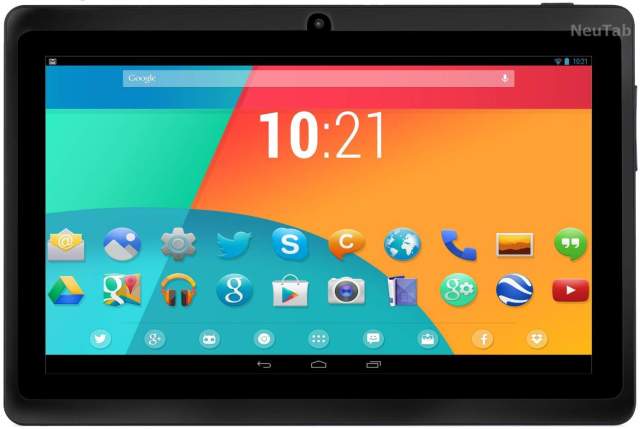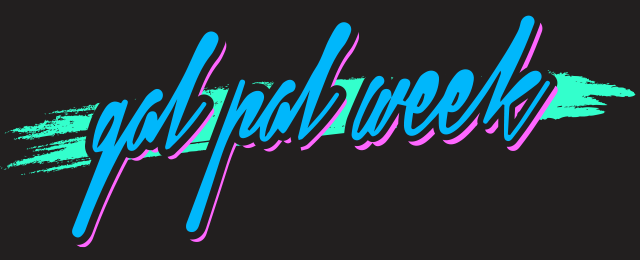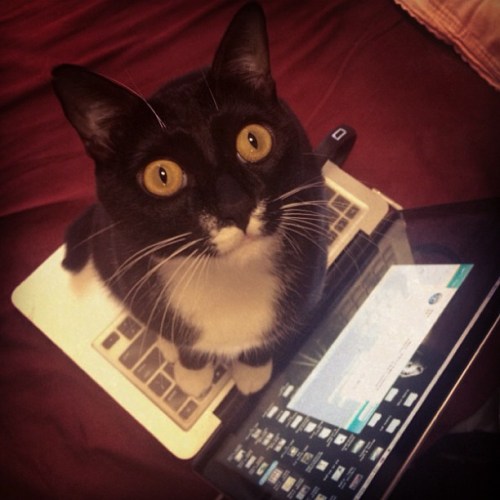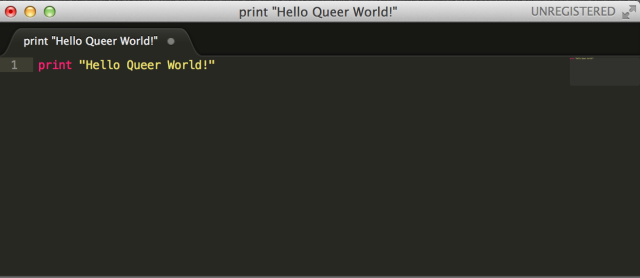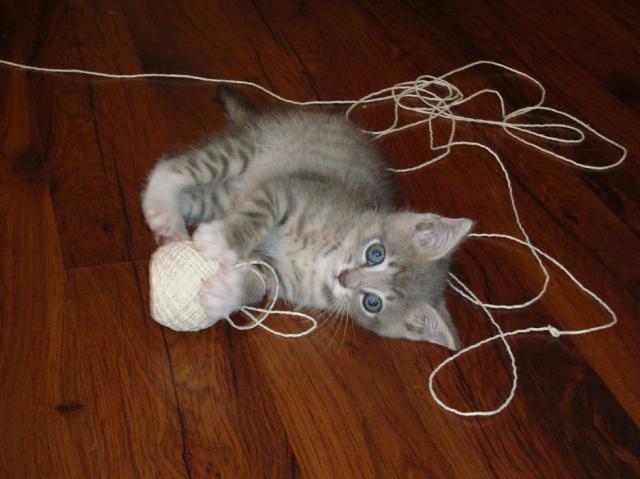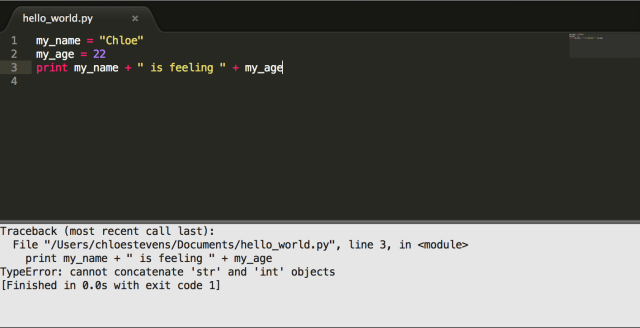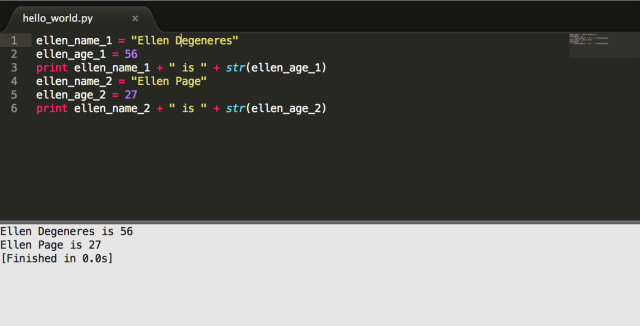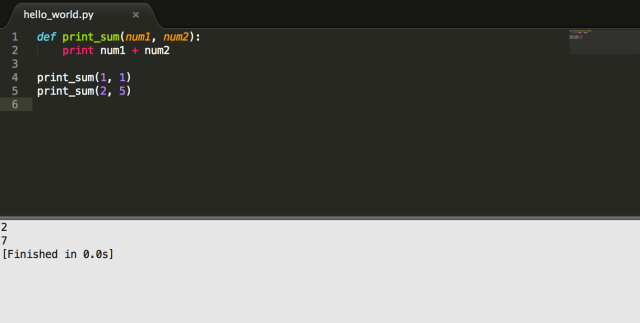Get Fried (for Hanukkah!) with Latkes
feature image via shutterstock
As a high-holiday Jew whose strongest religious connection is with Jewish cooking, latkes are one of my most visceral foods. They smell like my birthday and my mom making my favorite food and eating with my hands standing next to the stove while I wait for the next batch to fry. Holidays are a weird time for me living thousands of miles away from my friends and family, and making my tiny one-room apartment smell like fried potatoes for days and days helps me feel a little less far away.
Latkes are also really easy, can be made with everything found in a severely understocked kitchen (hi, I’m single and I live alone, why do you ask?), and everyone likes them because they are literally just fried potatoes and everyone loves fried potatoes. Not that you need any more reasons to cook latkes, but it’s Hanukkah this week and latkes are a traditional food so you get to eat fried potatoes under the guise of tradition! This recipe makes about 15-20 latkes.
Ingredients
- 4 large Idaho potatoes (otherwise known as the normal potatoes found in every grocery store across America, but found in exactly zero stores in all of Switzerland so I used smaller potatoes and they came out fine)
- 1 onion (white or yellow)
- 2 eggs
- 1/4 cup of flour
- 1/4 cup of oil (I used sunflower, pretty much anything is fine)
- salt and pepper
- optional: lemon juice, if you’re not cooking them right away
- a cheese grater, or a food processor if you’re fancy
- a frying pan
- paper towels
Preparation
First step: peel your potatoes. As I peel them I put them in a bowl of cold water after they’re peeled which keeps them from browning I think? We always put them in cold water and at this point I’m too superstitious not to.
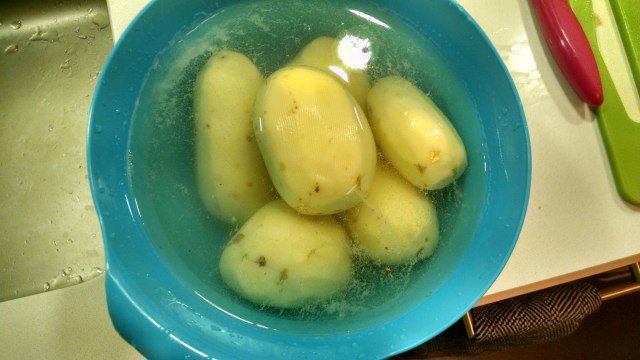
They get more delicious I promise
Grate the potatoes into a bowl using a regular cheese grater, or if you have a food processor you can use that. I’m not even going to get into the pulverized versus shredded debate, but I am #teamshredded. Peel the onion and grate the onion into the bowl as well (warning: this will get onion juice everywhere. I was determined to continue grating despite impaired vision and accidentally grated my thumb. I instead recommend these stylish onion goggles).
Once you’ve grated the onion and potatoes, you have to press out the extra water, which makes the latkes fry better. I do this by covering the top of the bowl in a couple paper towels and pressing down hard a couple times. You could use a dish towel if you’re the kind of person who regularly washes their dish towels, or you could use a fine sieve or colander (see above re: understocked kitchen).
Next, add the eggs, flour, and salt and pepper to taste (I don’t know, follow your heart, I just shake it in for a while) and mix everything up. Important: if you are not going to cook the latkes right away, cover the potatoes in lemon juice otherwise they will turn black! Also put them in the fridge, very important!
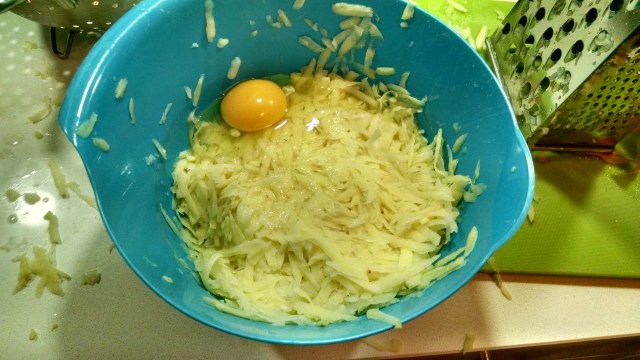
Oh did I not mention you are going to get shredded potatoes everywhere?
Frying
Once it’s all mixed, you’re ready to start frying! Put some oil in your frying pan (enough to thinly cover the bottom), put the heat on medium-high, and give the pan a few minutes to heat up. Take a medium-sized spoonful of potatoes and put in the oil, then flatten it out with the spatula until it’s about 1/4-/1/2″ thick. Fry for 1-2 minutes on the first side (or until light-brown), then flip, and fry the other side also until golden brown. When I take my latkes off, I like to put them on a plate with a paper towel, which absorbs the extra oil. I usually change the oil every two rounds of frying, but it’s up to you!
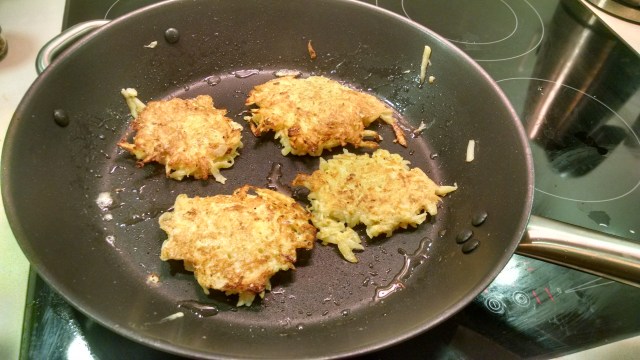
This is approximately what they should look like at this point
If I’m making a lot of latkes, to prevent the earlier batches from getting cold I turn the oven on to 200F and put them on a cookie sheet, or just serve them right out of the frying pan as they’re ready, as my mom always does.
Last but so very much NOT least, I feel really, really strongly about what latkes should be served with. There are only two appropriate condiments for latkes: sour cream and applesauce. You do you, but if you put ketchup on your latkes my Jewish grandmother will turn over in her grave. I got really ambitious during this round and cooked applesauce while I was prepping the latkes using this recipe and I didn’t even burn anything.
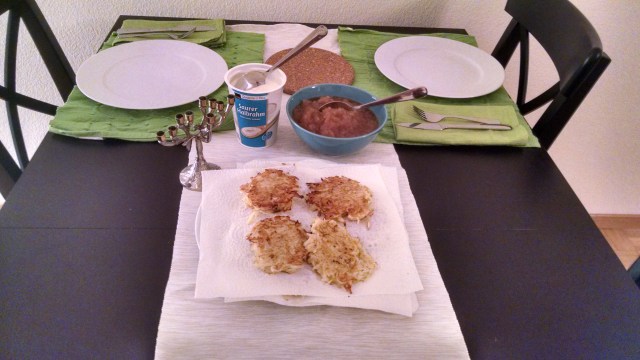
Just don’t tell my mother I couldn’t find any candles that would fit in the Menorah.
Here’s What Lesbians Who Tech In Berlin Was Like (It Was Awesome)
As a Software Engineer who relocated from the bay area to Zürich, Switzerland, I was super excited to see Lesbians Who Tech coming to Europe and immediately grabbed a ticket. I had attended happy hours and the first summit in California, but living abroad has made it hard to find a local queer community, let alone a community of queer folks in tech. Conversations around both LGBTQ issues and technology look really different in Europe. Countries vary wildly in their tolerance, with very different approaches to issues. In my experience living in Switzerland, people tend to be on the whole more private about their sexual orientation. Additionally, in many places in Europe (especially Germany, the location of the conference) new technology is greeted with widespread skepticism and privacy concerns not found in the U.S. So I was both excited and curious going into the conference.
Leanne Pittsford, Lesbians Who Tech founder, put together an incredible agenda for the event, kicking off the week with several evening get togethers. On Thursday I attended a meet up with Unicorns in Tech, Germany’s first tech community for LGBTQ folks and allies, and Berlin Geekettes, a community of women tech innovators. I had a great time getting to meet folks from the Berlin tech scene, which is (at least for an American software engineer well-versed in the gospel of Silicon Valley as the tech capital of the world) surprisingly large: Berlin is home to dozens of startups, and larger companies like Google, Twitter, and Github have satellite offices in the city. This meetup had a nice mix of folks visiting from out of town, and those who worked locally in the city and could speak to tech life and the LGBTQ scene.
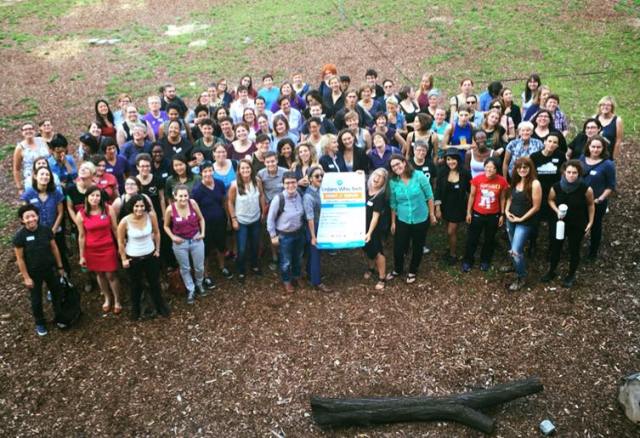
The main event on Saturday kicked off with Leanne telling the Lesbians Who Tech story, which by the end had me feeling quite inspired to start a chapter in my city. She offered advice for starting a group to create any kind of community. First, to begin by giving to that community; rather than starting with demands, think of what you can offer, and then to show up and offer it. Second, to make sure that your leadership looks like the community that you’re trying to serve; this should be obvious but is often forgotten in the tech industry, where only 22.5% of leadership roles are held by women. And lastly, and for me most importantly, if you want to build a community of or with queer women, do not start an LGBT group and hope for the best, instead start with queer women and build out the community from there. As queer women, we are so accustomed to seeing LGBT implying a majority of cis, gay men that we often don’t even bother to show up. We can’t expect to open LGBT spaces and assume that women, people of color, and trans people will know to feel safe and welcome. If we instead start spaces like Lesbians Who Tech, and begin by engaging underserved groups, the community will be more diverse and welcoming from the start.
The other highlight of the morning was Dominique DeGuzman’s “Breaking the Bro Code: #iLookLikeAnEngineer.” She talked about repeatedly having to prove her existence, worth, and identity, to herself and to others, including some intense though unfortunately unsurprising examples of ignorance and intolerance she’s encountered. She ended with the simple message that she has nothing to prove to anyone who doubts her, and in particular, “I’m female, I’m queer, I’m Filipino-American, and yes I’m a fucking engineer.”
https://twitter.com/mollyclare/status/637648073750151168/photo/1?ref_src=twsrc%5Etfw
This message of not having to prove our existence and value returned throughout the way, a refreshing change from Lean In style, “speak up for yourself!” type suggestions that are often the central message of events for women in tech. Another talk in the morning entitled “The Marginalization of Design and What Ada Camp Taught Me About UX” (given by Cory-Ann Joseph) centered around the sad interactions that designers frequently have with programmers, in which their work is devalued for being being less technical and they are assumed to be less rational, technical people. At a typical tech event, the ending question of “How do you talk to people whose default assumption is that your work matters less?” might have been answered with techniques for coping under these circumstances, the speaker chose to end the talk with a concise “Tell them to go fuck themselves.” You all, I am all for solution-driven approaches, but sometimes it feels so good to just be with people who understand and forget about everyone who doesn’t, even if for a day.
I was also inspired to learn about the work currently happening in Europe around diversity and technology. Most diversity efforts I know of are based and primarily operate in the US, and so I previously held an entirely false assumption that the US is where most conversations around this issue are happening. I am excited to report that throughout the day I was able to learn about so many incredible organizations that proved me entirely wrong. We heard from Brigitte Jellinek, who teaches women to code through Informatica Formale, a summer university exclusively for women that has been running for 18 years. I learned about Rails Girls Summer of Code, a global fellowship program to bring more women into open source, and codebar.io, a British nonprofit dedicated to growing a diverse tech community through coding lessons and mentorship. The amount of community-led, grassroots work showcased throughout the day was really impressive, especially in contrast to similar conferences that tend to highlight more corporate, top-down approaches to the issue.
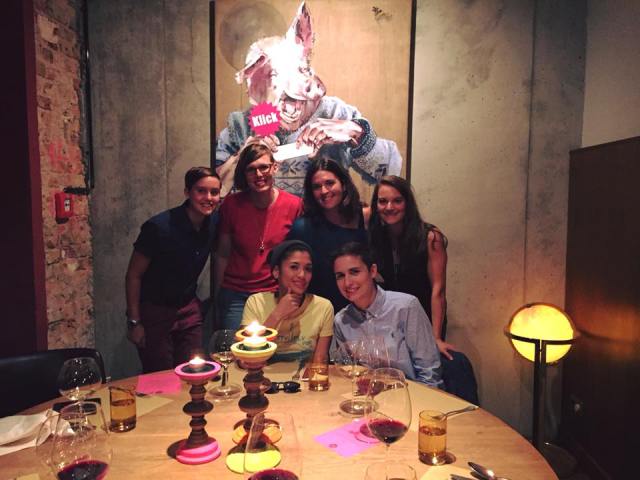
Dinner at Twitter, weirdest photo ever.
For me, the highlight of any event like this is “the hallway track”; the conversations and interactions with a diverse group of queer women I would have never otherwise had the opportunity to meet. I met women who have founded companies, students looking for mentorship, Autostraddle readers, artists, venture capitalists, and everyone in between (by the afternoon I had even been invited to give a guest lecture on web development at a University in Austria). Making these connections motivates me to stay in technology: finding role models and mentors, feeling inspired by queer women venturing out on their own, but mostly remembering that I am not alone. Queer women in tech exist all over the world, and being able to find each other is pretty fucking cool.
This has been the one-hundred-forty-fifth installment of Queer Your Tech with Fun, Autostraddle’s nerdy tech column. Not everything we cover is queer per se, but we talk about customizing this awesome technology you’ve got. Having it our way, expressing our appy selves just like we do with our identities. Here we can talk about anything from app recommendations to choosing a wireless printer to websites you have to bookmark to any other fun shit we can do with technology. Header by Rory Midhani.
Program A Tiny Computer, Queer Your Own Tech
Previously in Queer Your Tech, Ali mentioned Jewelbots, which are programmable friendship bracelets described as an “open source wearable for teens.” I am a big fan of the “internet of things,” a blanket term for physical, programmable objects with the ability to connect with one another through networked communication, for several reasons. Projects like Jewelbots have incredible potential to engage a broad range of people in programming, technology, and innovation. If the success of the this Kickstarter is any indication (over 4x the funding goal reached), teenage girls have plenty of interest in programming when it is applied to a problem or device that is interesting and valuable to them.
This idea can be extended far beyond Jewelbots and teenage girls; what if anyone who wanted to could buy a small computer at a very low cost and program it to solve their problems? Not only does the availability of this hardware teach more people to program, it also opens up incredible potential for innovation. If you have an idea for a new device and can build it with $40 and basic programming skills, you can actually just build that device. I personally am excited and hopeful for a future where folks from a much, much broader range of backgrounds are creating new technology. I HAVE SOLD YOU ON THIS IDEA, I CAN TELL.
But how do you get started? There’s a wide range of devices available for consumer purchase, each requiring slightly different skills. Here’s a roundup of some options, what they can do, and how you can get going programming one!
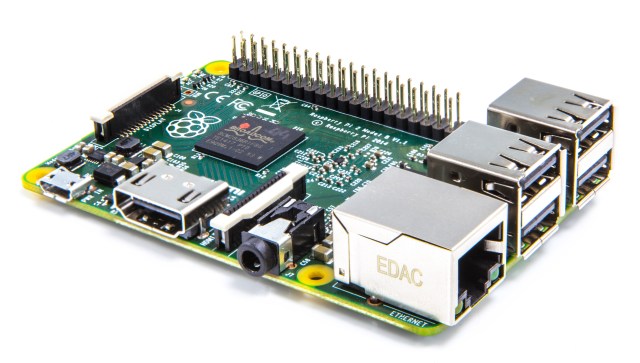
via Raspberry Pi
Raspberry Pi
Up first is the Raspberry Pi, a credit-card sized computer and the first and most widely-distributed small, programmable device in the world. Originally released in 2012, the Raspberry Pi took off among hobbyists, educators, and even serious programmers as a low cost device for tinkering, inventing, and teaching programming. The original model is $21 on amazon, and all that’s required to get started is a keyboard and some sort of external display, such as a TV, laptop, or monitor. A starter kit can also be purchased that includes cables, a charger, a wifi chip, additional storage, and other nice-to-haves. There are several different models of the computer available, nicely broken down in this chart. The great thing about Raspberry Pi is that it’s backed by the Raspberry Pi Foundation, a non-profit dedicated to advancing computer science education in schools, so purchasing one supports this effort.
Once you’ve purchased a Raspberry Pi, there is a decent amount of setup required, and then you are able to begin programming the device using Python, which comes preloaded on the device. I wrote up a gentle introduction to Python, and the Raspberry Pi foundation has some great resources for learning the basics as well. Once you get started, the possibilities for what you can make are pretty much endless.
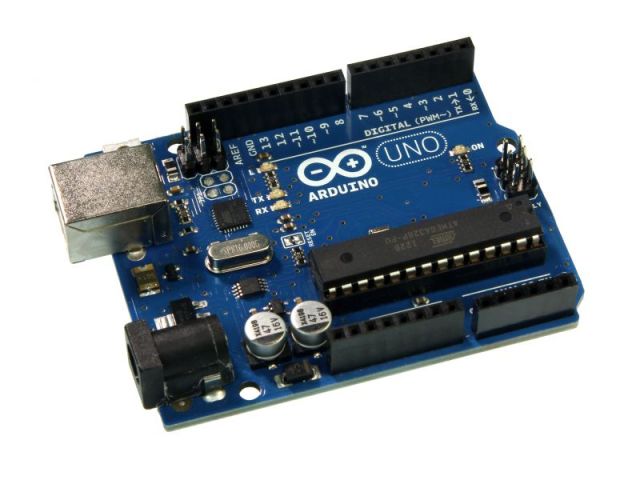
via Solarbotics
Arduino
Arduino is the main Raspberry Pi alternative for small, programmable computers, with the main difference being the Arduino is substantially simpler and less computationally powerful. The set up is much easier for an Arduino, which can make it a better choice for absolute beginners. The Arduino, because of its simplicity, is also easier to hook up to other devices, such as LED lights, sensors, etc, and so might be a better choice if you’re looking to learn and use the basics of electronic circuits. Price-wise, the Arduino is similar with a basic board costing $25 and a full starter kit at $54. Arduino can be programmed using its own “Arduino Programming Language,” essentially C with some C++ niceties. I personally find this a little bit harder to get going with than Python, but there are numerous online tutorials available and lots of examples for getting started.
Android Devices
For more advanced programmers, there are a surprising number of affordable Android devices for sale, i.e. low cost tablets and even phones for under $50. The advantage of purchasing a phone or tablet is that you already have a high level of software/hardware integration to get started with, including bluetooth, wifi, battery power, motion/light sensors, and a camera. Android runs on Java, which as programming languages go, is a happy medium between Python and C. The Android Development Manual offers some good jumping off points for getting going with Android, but there is quite a bit of initial setup involved, and so I would steer absolute beginner programmers away from this option. You can do some really cool things once you get going, though, for example automate your home or you can literally build a robot.
Bonus Project Ideas
- Build your own open source smartwatch
- Be the most dapper nerd with this internet controlled light up tie
- Measure your own water use; probably save the world in the process
- This is a programmable menorah which I fully intend on building before Hannukah this year
- This is a tiny arcade. Do I need to even write anything else, ever?
This has been the one-hundred-fortieth installment of Queer Your Tech with Fun, Autostraddle’s nerdy tech column. Not everything we cover is queer per se, but we talk about customizing this awesome technology you’ve got. Having it our way, expressing our appy selves just like we do with our identities. Here we can talk about anything from app recommendations to choosing a wireless printer to websites you have to bookmark to any other fun shit we can do with technology. Header by Rory Midhani.
Interview With My Queer BFF: Chloe Interviews Abby (and Riese)
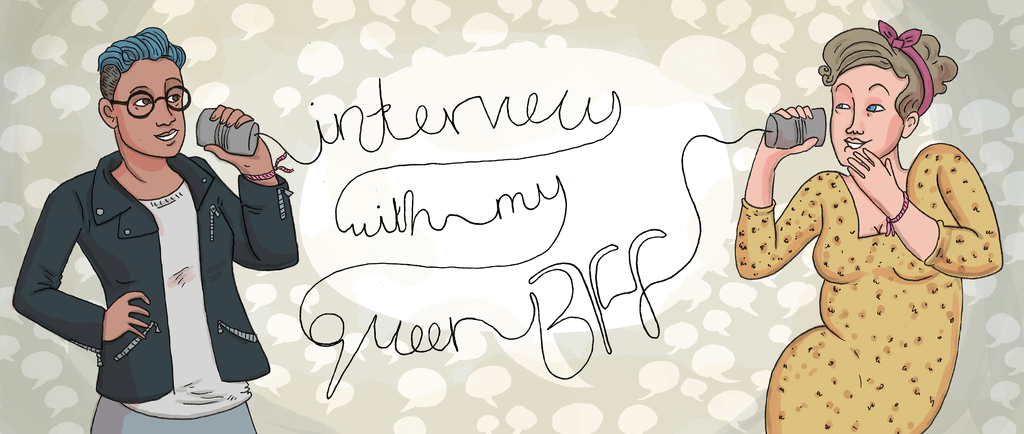
Header by Rory Midhani
Far too often our queerness is only discussed in three contexts: relationships, family and politics. But our queerness plays a role in our friendships with other queers, too, and that’s what this series is all about. In honor of Gal Pal Week, welcome to “Interview With My Queer BFF,” in which gals interview their best queer pals about their exciting queer paldom. And by “gal pals” we don’t mean “girlfriends” or “wives” … we mean GAL PALS.
Today, Intern Chloe is interviewing her BFF Abby, who also happens to be Riese’s fiancé.
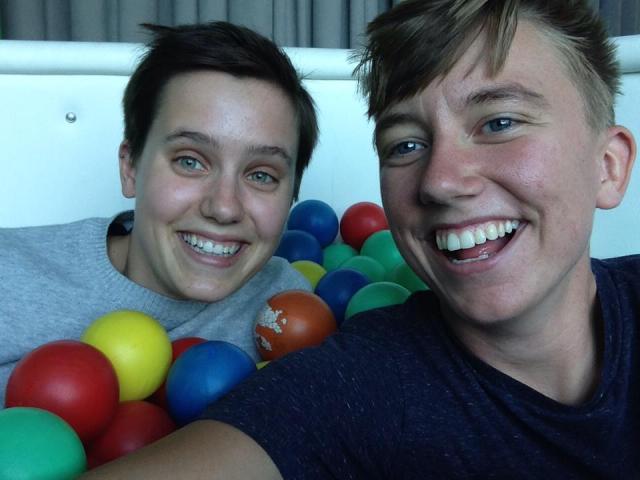
Chloe: How did we meet?
Abby: We met at A-Camp, May 2014, and I found out that you were basically an extension of me, in a lineage that I had no choice but to abide by. And we took romantic walks at sunset, we ate breakfast together, and then I forced you to be my best friend and confidant.
C: That’s basically what happened, I think that pretty much covers it.
A: I think I pretty much just like forced you into a relationship with me with none of the benefits, thats pretty much what’s happening.
C: So, why are we friends and not girlfriends?
A: We are both… (laughs) um oh that’s a hard one. I think it all comes down to to I already fell in love with somebody else. It was like right at the same time. I don’t know, that’s a hard question.
C: I think that we’re just too much like each other. I don’t think that I ever would’ve, like… it would’ve been like having sex with myself?
A: Which is still great.
C: Which is kind of great and also kind of strange and also we immediately knew so much about each other.
A: Yeah, it was a very high stakes environment. Also I’m very much in love with you as a person. It’s not like we have these weird boundaries, I don’t feel like that exists necessarily, but… I don’t know. I guess there just some level of that person already exists in my life. The girlfriend person. I love her in a way that I guess I’m just not available for that? But it’s not that I love you any less. It amplifies it. I feel like that’s tricky because girlfriends and best friends have kind of an overlap. It’s a venn diagram. We’re a venn diagram.
C: I’m single right now, but when I met you I had never met anyone who was so much like me and it felt that good, and it never occurred to me to be like “I should try to fuck this up by sleeping with you.”
A: When you start dating someone in that way, there’s that kind of inevitable, unless you’re planning a life partnership with someone, that there’s a feeling that this could run off the tracks at any time, and it was very apparent that that wasn’t going to happen with you, therefore we have never dated. I think that’s a good answer.
C: No, we’re not gonna go off the tracks.
A: We’re on the pal train… forever.
C: It’s like the Caltrain, but with fewer disruptions to service. Do you think our friendship would be different if we were straight?
A: I can’t even imagine a world in which I’m straight, I just can’t even go there. All gay, all the time. I just feel like when you ask that question I see this Star Wars text going off into oblivion and it’s like ‘in a world’… and I’m like this isn’t real, this is as real as Star Wars to me.
C: I don’t feel straight ever.
A:I feel like straight girls are pretty gay regardless, in their friendships at least. If we were straight girls, I feel like we’d be those annoying straight girls, like “look at me and my girlfriend!”
C: We’d probably be really annoying, appropriative straight girls who are acting like lesbians.
A: We’d be so annoying, honestly, I feel like our friendship would be pretty much the same.
C: We’re annoying anyways.
A: I would still have a collection of pictures of you around my house, regardless. Like my boyfriend would be on top of me and I’d be looking at a picture of you.
C: I’m pretty sure that happens anyways. Ok, next question. I want to ask you which of my exes did you hate the most but I feel like there’s only one answer, you’ve only met one of them.
A: I have opinions on many of them. But yeah, I think you know. I guess in a way, like I totally respect and love you, and we’re the same age, so I respect you as a fellow adult who can make their own decisions, but there still is an element of being protective of you. Just like I think you’re very protective of me, so when anyone comes in the periphery, it’s like “who the fuck is this” regardless, even if they’re like, an angel. So anyone who wants to date you, I’m like “let me see your resume.”
C: I guess you’re supposed to be asking me questions, do you want to pick one now?
A: Yeah I do. Ok. What role would I play in your wedding?
C: Altar boy.
A: The pope? Can I be the pope?
Riese [shouting from other room]: Did you tell Chloe how she’s gonna be your best man and walk you down the aisle?
C: I would love to walk you down the aisle! Can I wear a dad sweater?
A: None of us have Dads.
R: We have no men in our family, they all left or died.
A: Wait, so I would be altar boy in your wedding?
C: You could be the pope, I like that.
A: I don’t know why I assumed the pope would be at your wedding.
R: The pope??
A: You are not being interviewed!
R: Don’t you want to talk to me?
A: I’m really glad my girlfriend’s like “listen to me!” I would be the pope.
C: I’m glad we sorted that out.
A: Wait, could I be the bride? I would be the bride at your wedding. OK, what’s the most annoying thing about me?
C: There’s nothing! That’s a horrible question.
R: Also by the way I’m not here to spy, I’m just here because I just actually want to sit on the couch and you both are also sitting on it.
A: I mean you literally know all these things, you know that I’m obsessed with Chloe. You know that when I said what role I would play in her wedding I said bride.
C: No, no actually I do have an answer. The most annoying thing about you is when you’re being intolerable with your girlfriend in public, and wondering why people act weird around you guys in public, and it’s in the middle of you guys talking about anal sex making weird faces at each other, and I’m just sitting there, like kind of entertained and kind of embarrassed. I’m not even a third wheel, I’m like a trailer or something.
A: OK, well here’s the most annoying thing about you, which by the way you don’t even have to ask me, is obviously: you think you’re a third wheel! And you won’t just join in the fun.
C: You think I need to be more of a weirdo in public with you and your girlfriend?
A: No I think you need to pretend that you are also our girlfriend. The most annoying thing about you is that you are not also our girlfriend.
R: This is a really good segue into something Abby wanted to talk to you about already.
C: What did you want to talk to me about?
A: That you’re not my girlfriend, I wanted to ask you out. It was gonna be really romantic.
C: I think Riese might be kind of upset.
A: Oh she’s fine, don’t pay attention to her. She’s not even supposed to be on the couch.
C: What’s the most embarrassing thing you’ve seen me through? I don’t actually think I’ve done that many embarrassing things in front of you.
A: I hear about awkward things second hand. You know, it’s so embarrassing when we go to a restaurant in Switzerland and you don’t know how to speak Switzerland.
R: Isn’t is so embarrassing when you go to a restaurant with somebody wearing jeans that had so many holes in them they almost had more holes than fabric?
C: I don’t think I ever took Abby to a restaurant when she still owned those jeans.
R: Yeah remember, we went to the Burgermeister, and you’re like you need new pants.
C: No, I was more embarassed by the two of you as a couple than I was by Abby’s pants.
A: I don’t think I’ve seen you through that embarrassing of situations. You’re pretty level-headed. Which is good, for every embarrassing situation I get us into, you’re very level-headed about it. I’m much more of an extreme person. You have your extremes, but they’re more grounded. I’m flying at like 7000 miles an hour.
C: Sometimes. Okay let’s just do one more. What have you learned from our friendship?
A: I’ve learned a lot actually. That you don’t have to sleep with your friends for them to like you. Which for me is a really important lesson.
C: From me? I’m honored.
R: I remember when I learned that, it’s a pretty big deal.
A: It is a big deal! That someone’s gonna love me unconditionally, even if I don’t have to fulfill something with you, makes me want to be with you all the more. And that’s important. If I had to go on a Mars Rover tomorrow, the two people I’d want to see most are on this couch.
C: Aww.
R: I feel like you’re implying that you’re shipping me to Mars.
A: You’re not in this, you’re out of this! Also, I have learned to be more emotionally open with my friends, which is not my forte. I really appreciate that you let time happen in between when I have to talk about things. Like things will happen and people will find out and right at that moment people will be like, “Are you ok, do you have to talk?” and you always almost wait for me to come to you.
C: But I get that, because I don’t usually want to talk about things.
A: But I think that’s rare in a friend, and I think it’s so nice that we’re both that way, going back to how similar we are. I know that when I crawl out of my cave you’re gonna be there. What’s something you’ve learned from me?
C: Riese is gonna laugh because its gonna sound really corny, but I just remember this moment that we had at a camp, and we’re walking off to have a talk for the first time, and you were like, by the way I’m not totally gay, I’m bisexual, and I just felt for the first time that I could actually just be completely honest and unapologetic about my sexuality. Even at a camp where I felt like I was sort of coming into my own as a more — I don’t really like “masculine-of-center” but you know what I mean — but just my identity in general, that your existence and your total willingness to be like “this is who I am” but not in a “fuck you” way, but just in a really honest way, but you were just so honest about it that it made me feel like it was ok to be honest about my identity.
R: YOU GUYS!
A: You are not in this! Leave!
C: But also I have one more thing. I am always learning from you to fly by the seat of my pants a little bit more. You have this amazing way to be super spontaneous and also do things that make sense. When you just decided to move to California, it was totally crazy and went against all these plans that you had, and I was like “Abby that’s totally crazy what are you doing,”and you had it completely logically planned out about how it was gonna work. I realized it doesn’t have to be one or the other, that you have to be completely logical and following plans or you have to be completely spontaneous and making a mess of everything because you found a way to have both.
R: You can spontaneously make plans.
A: You can be like I’m gonna make this mess, but this is how I’m gonna clean it. I have already bought the mop.
C: You definitely bring me more out of my too-calculated world.
R: That you can be spontaneous and still safe.
A: Well guys! This is so sweet.
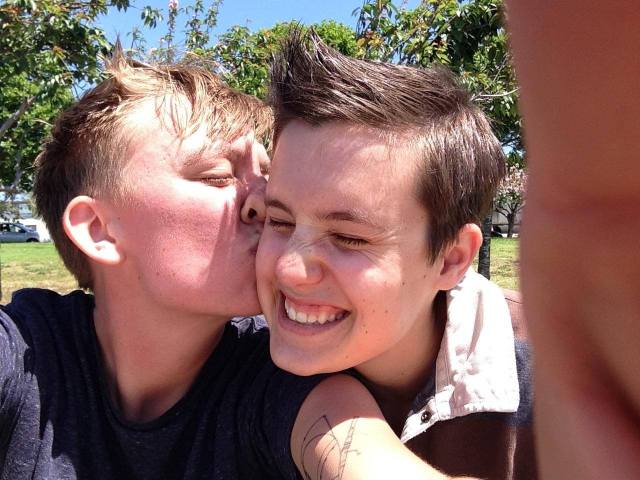
Top 8 Weirdo Things I Ate During Passover
My Grandma Betty made up all her own rules of kosher eating. Bacon: kosher. Ham: not kosher. Lobster: kosher. Crab: definitely not kosher. Passover was quite an event in my mom’s entirely untraditional, 50s Jewish household. My mom told me horror stories of her mom keeping live gefilte fish in the bathtub, and nostalgically remembers eating roast every Friday night for shabbat, even though no prayers were ever said.
I never met my Grandma Betty, but she was a notably eccentric woman, and I consider myself lucky that her name lives on as part of mine. Betty came through Ellis Island when she was 6 years old, leaving eastern Europe less than a decade before the start of World War II. The spirit of Passover is acknowledging our ancestors, but even more so in acknowledging the value in tradition. 357 days a year I pay little tribute to my Jewish heritage; I don’t go to temple or cook Shabbat dinner or know how to read Hebrew, but for 8 days I do my very best to follow my own mostly arbitrary and ever-changing rules of pesach. For a person whose diet is at least 78% pasta, even cutting out this one food presents a test of personal will, so I allow myself some leniency. But I think Betty would approve.
This year Passover presented an even greater challenge, since I recently moved to Switzerland, can’t read any ingredients on any food item, and generally can’t buy half of what I’d like to eat in the grocery store. I spent the first half of this Passover week traveling in the Netherlands, and so between the two countries I now present the official list of Weird Shit I Ate in Europe While Attempting to Keep Kosher for Passover.
1. Tomato soup
Four times in two days. One time I ordered it and it came with croutons so I just ate around them.
2. Coconut bread
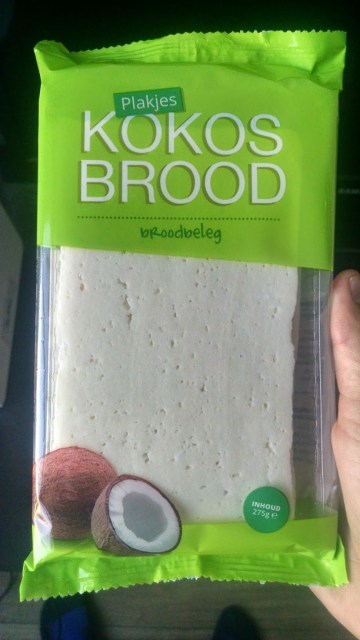
3. A spinach salad that cost 15 euros
I had spent the morning exploring a new city, and twice tried to stop for lunch. The first time the only non-bread item turned out to be soup with bacon, which is out even by my rules, and I struck out a second time attempting to order something that roughly translated to “bowl of vegetables”. By the time I found this spinach salad, it was 3 pm and all I had consumed that day was two shots of espresso (coffee is always kosher, I mean let’s be reasonable). It was hands down the best spinach salad I’ve ever had.
4. Hard boiled eggs and roasted red pepper sauce on matzah
Eaten for breakfast three days in a row. The Swiss notion of breakfast is weird enough to begin with, and a lot of people just eat normal sandwiches for breakfast (which in my opinion is an abomination to breakfast), but my normal options of Muesli, toast, or oatmeal were all out so the unusual eggs/pepper combo seemed like a reasonable option. There’s nothing like being the weirdo in the cafeteria carrying around a ziplock bag of matzah.
5. Matzah Pizza
The best Passover dish is obviously matzah pizza, which is like normal pizza except what it would taste like if you tried to bake it on top of a crumbling pile of crackers instead of dough. I usually love matzah pizza, but the first time I made it this year I somehow managed to use way too much sauce and so the matzah got all soggy, and soggy matzah might just be the worst way to eat matzah.
6. Something called Chocoladepasta
I only bought it because it combined “chocolate” and “pasta” into a single word so I had to. I couldn’t read the ingredient list but I’m pretty sure it was kosher. I ate it on matzah, duh.
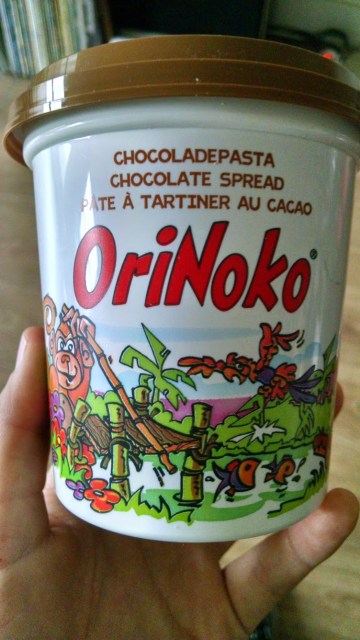
7. A single egg, made in a miniature pancake pan
This was probably the saddest meal of Passover, because who wants to eat just a plain fried egg? I love fried eggs, but they just need toast so badly. This was a tough breakfast.
8. Super nachos
This was my biggest slip up, and it happened about three hours after Passover started. I generally eat according to Ashkenazi tradition, which is supposed to mean no grains or seeds but I take to mean grains, except soy, and other things when I’m really desperate. What happened was that I landed in Amsterdam, and the first food offered to me was nachos, one of the greatest dishes ever to be served ever and which I have not eaten in 4 months since I was last in the US because nachos and components of nachos just do not exist in Switzerland. So my friend asked me if I wanted to order nachos and I said NO THANK YOU because I am strong, and I can last three whole hours without grains. Then I tried to order wings instead, and they were out of wings. There was only one logical choice, which was to eat the nachos: corn chips, beans and all. I decided to keep kosher for an extra three hours after sunset on the last night, because this is what my grandma would do.
Beyond Storytelling: Actionable Ways to Help with Tech’s “Woman Problem”
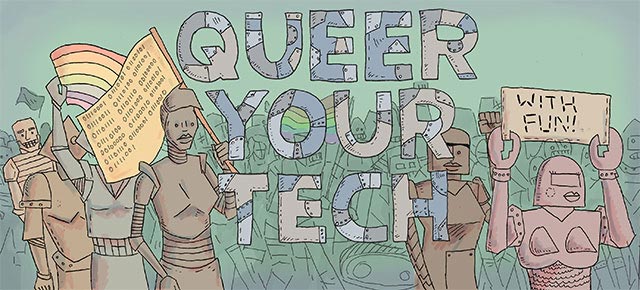
Feature image via Shutterstock
I recently read a Stanford student’s account of being “floored” by sexism in the workplace. I was more floored that many people seem not to realize how pervasive this student’s experiences are. I work for a large tech company as a software engineer. I can’t count the number of times I’ve been mistaken for a recruiter, mistaken for a man, mistaken for other women in my job position (because apparently there is only one of us), talked over in a meeting, or told off for not knowing a term or concept. And I consider myself lucky that I’ve never dealt with explicit sexual harassment in my workplace, a gift I attribute to loudly and frequently announcing that I only date women. But I don’t want to talk about my tragic life as a female programmer. How many times do we have to tell these stories before they become real — before we all agree that this is a problem, and more than that, agree to do something about it? The conversation around sexism in the tech industry is completely halted in the “telling our stories” phase. I am sick of talking about “tech’s diversity problem.” I want to move the conversation forward, and I want to make things better.
Actionable Allyship
Though allyship as a concept has its issues, we must find meaningful ways to engage allies in this conversation if we seek to improve or eradicate sexism in tech. What would active and actionable allyship look like? The Ada Initiative, a non profit supporting women in “open technology and culture,” runs an Ally Skills Workshop focused on awareness of issues faced by women in technology and bystander intervention for men to contribute to combating those issues. For example, men role play situations in which they call others out for everything from casual sexism to harassment. The workshop is intentionally queer and trans inclusive, and Ada Initiative will send experienced facilitators to workplaces and nonprofits to lead it.
Sometimes active allyship is more subtle than bystander intervention. I couldn’t begin to enumerate the number of impostor syndrome inducing lunchtime debates about programming languages, the disbelief that I don’t play video games or generally participate in many aspects of “programming culture.” We need to change what programming culture looks like. Both women and allies can and should actively work to combat the dominant narrative of programmers. Some programmers love videogames; some don’t. Some were given a computer for their fifth birthday, some (like me) didn’t start programming until college, and some are self-taught much later than that. I believe it’s possible to create a space where all these stories are welcome, and where your interests and background doesn’t determine your technical aptitude. A shift away from the dominant narrative requires all of us in tech to take responsibility for the spaces we create.
Additional reading that you can send along to would-be allies: Six Ways to Support a Diverse Work Culture, So You Want to Be an Ally, Making Tech Spaces Safe for Diverse Faces.
Visibility
We’ve already covered how visibility is a huge issue, but why does this have to be the case? Though women in tech make up far less than 50% of leadership teams at major tech companies, we certainly don’t comprise 0% of leadership. Grace Hopper Conference boasts 8,000 attendees, and yet still women fight the problematic assumption that they simply can’t be an engineer because there are so few of us. The longer this conversation stays focused on how few of us there are, the more we take away the opportunity to tell success stories.
How do we concretely improve visibility? Give women the stage at major tech events, and let them actually speak. And don’t give women the stage to fill a quota or talk about gender issues. Give them the stage because incredible women in tech really do exist. For those of us that don’t select keynote speakers at major tech events, we can start by learning these women’s names, the companies they’ve founded, their achievements. Here’s a list of 50 to get you started. Other efforts exist to provide more concrete visibility, for example Project Diane seeks to “disrupt pattern-matching in tech by identifying black women founders of tech enabled companies.” By creating whatever platforms we can for women founders, programmers, engineers, and entrepreneurs, we offer role models for those of us who are just starting out, who are discouraged by tech culture, who need to know that people like us can succeed.
Go Beyond “Lean In” Tech Feminism
I probably don’t have to convince you that “Lean In”style feminism is grossly inadequate, and basically excludes all non-straight, white, cis, educated women. With Cheryl Sandberg as possibly the most famous voice in this conversation, existing solutions tend to center on the most privileged women while leaving the most vulnerable women behind. For an industry that claims to be so progressive, we lack any acknowledgment of intersectionality when we approach this issue.
The much-needed ability to design solutions that center trans women, women of color, and women who took nontraditional paths into technology requires a major change in perspective. We currently seem to think of this issue in two types of changes: recruiting (the pipeline is so small and this is why we can’t hire women, so we must increase the size of the pipeline), or changing women’s behavior (Lean In). We can’t fix this problem unless we acknowledge the real and systemic discrimination that marginalized women face, even in the so-called meritocracy of the tech industry, and then fix those issues instead. Let’s change men’s behavior by actually taking sexual harassment in the workplace seriously. Companies need to reexamine hiring and promotion processes under the lens of discrimination. We also can and must use the above suggestions for allyship and visibility to help all women, not just cis, white women.
How You Can Help Right The F*ck Now
Last year, I taught at Bootstrap, an open source functional programming curriculum to middle schoolers through Citizen Schools to try to increase accessibility of programming in low income middle schools. Similar organizations you can get involved with, donate time or money are Mother Coders, TransTech Social Enterprises, Black Girls Code, Hack the Hood, CODE2040, and Girls who Code.
How are you moving beyond storytelling into action? Please let me know in the comments!
This has been the one-hundred-twenty-third installment of Queer Your Tech with Fun, Autostraddle’s nerdy tech column. Not everything we cover is queer per se, but we talk about customizing this awesome technology you’ve got. Having it our way, expressing our appy selves just like we do with our identities. Here we can talk about anything from app recommendations to choosing a wireless printer to web sites you have to bookmark to any other fun shit we can do with technology. Header by Rory Midhani.
Programming Things 101: Hello Queer World!

Hi Queermos! I’m Intern Chloe, I’m a software engineer at a large tech company, and I want to teach you things about programming computers! Programming is one of my top three favorite activities, after eating pasta and responding to Autostraddle tech support requests. Hopefully you might want to program computers too, because there’s a ton of job growth in I.T., and while there are some pretty kick ass queer women programmers, tech is still overwhelmingly dominated by men. Also lots of girls seem to think my ability to program computers is a good reason to send me OKCupid messages, so.
Let’s talk about python. I picked python for our gentle programming introduction because when you squint really hard it allllllmost looks like regular English. There are dozens of programming languages that have different strengths and weaknesses, but once you know how to program in one it’s way easier to learn more. Python is easy to learn, but also super practical and is mostly what I use in my job.
There’s a tradition among programmers every time you learn a new language to have your first program be “Hello World,” which just prints out “Hello World.” That seems a little straight for us, so we’re gonna do “Hello Queer World” instead.
First, we need a text editor to write computer code in. I’m going to be using Sublime Text 2, which you can download for free and works on Mac, Windows and Linux. Once you’ve downloaded and installed, follow these steps:
- Open a new window
- In the menu, go to “View” > “Syntax” and select “Python.” This makes the code pretty colors, basically.
- Also in the menu, go to “Tools” > “Build System” and select “Python.” This tells the computer to read what we write as Python code.
- Then, in your window, type: print “Hello Queer World!”
It should look something like this:
The last thing you have to do in order to run your program is save it. On a Mac you can type command+”s”, or you can click “File > Save.” We’re finally ready to roll. Next, go to “Tools > Build” (or command+”b”) to actually run your code!
Does it print out something like this?
Hello Queer World! [Finished in 0.0s]
Let’s break this down a little bit. print is a special statement in python that allows us to write out information from the computer program when we run it. “Hello Queer World!” is a string. In programming, data can have many different types; a string is anything between quotation marks. Now, try to change your program to print out “Hello <your name>” instead.
Another common data type is an int, short for integer, which is pretty much what you might expect it to be, and we can do all sorts of normal math-type things with ints too. For example, all of these statements are valid:
- print 4
- print 4 + 5
- print -10 / 2
What happens if you instead type print “4 + 5?” Python just reads “4 + 5” as a string because it is in quotation marks, and so it doesn’t try to do math on it. Your window probably looks something like this:
Next we are going to talk about variables. Variables are a way of storing information that we want to use later on. For example, we could have a variable called my_name that stores a string for us. Then we can write something that looks like this:
my_name = “Chloe”
print “Hello” + my_name
And if you build this, it should print Hello <your name>. Variables can store any type of information; for example, maybe I also wanted to print out my age:
Disaster! This is our very first error message, which is telling us that we can’t add strings and ints together because they are different types. Error messages are really useful when you mess up — they try to give you information to fix the problem.
We can fix this by casting my_age to be a string instead — that is, changing it’s type for the purpose of printing it out:
Great job so far! You are learning so many things! Try making the above print statement more complicated and adding more facts about yourself using variables.
Ok ready for the last new big thing? The next major concept is called a function, which is a piece of code that you can reuse over and over again. For example, say I wanted to print out the name and age of anyone, not just myself. I could individually write out each print statement:
This is going to get really cumbersome because what if more Ellens come out? What then, will we just keep copy pasting code?! We need a function to end the madness.
def print_info(name, age):
Functions always start with a special keyword, def, which means that we are defining a function. Then comes the name of the function, print_info, and then the information that the function takes in — name and age. Below the function definition, we write the code that will be called every time the function is called.
def print_info(name, age):
print name + “is” str(age)
There are three important things to note about every function:
- The name: print_info
- The arguments: name (a string), age (an int)
- What it does when you call it: prints out name and age
A couple of things to notice about this code: mainly, you can think of print_info as a shortcut for the code inside the definition. Instead of having to type out the messy print statement over and over, you can just type print_info with the information you want it to contain. Also, notice how name and age look all orange and strange in the function definition. They are still variables, but a special kind of variable called function parameters that you send into the function when you call it, and then the function can use them like regular variables. Lastly, the line under the function definition is indented several spaces. Python actually cares about proper indentation, which means every time you end a line with a “:” you indent the next line 2 spaces. Sublime is awesome and will take care of this for you magically, but it is still worth knowing.
It’s super ok if this is confusing! Functions are scary and strange at we’re gonna do another example and then you can practice on your own.
Now, try on your own to write a function that takes in two ints as inputs and prints out the sum of them (I know it’s silly; bear with me). Ready go! Scroll below the next cat to find the answer:
Ok did you do it? Here’s my solution:
Cool! Great job! You know so many things about programming now! Though this is possibly the only “learn to program” guide on the internet using cat interstitials, you might want to learn more after this (I hope you do!). I highly recommend code.org for an excellent introduction. If you want to keep going, Coursera has a great selection of free online courses. What do you think? Was it confusing? Do you want to learn more? Were there enough cats? Tell me all your feelings about programming!
This has been the eighty-fourth installment of Queer Your Tech with Fun, Autostraddle’s nerdy tech column. Not everything we cover is queer per se, but we talk about customizing this awesome technology you’ve got. Having it our way, expressing our appy selves just like we do with our identities. Here we can talk about anything from app recommendations to choosing a wireless printer to web sites you have to favorite to any other fun shit we can do with technology.
Feature image via Shutterstock.
Header by Rory Midhani
